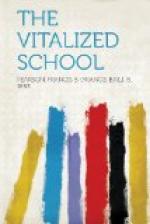=Machinery.=—She must challenge every piece of machinery that meets her gaze with the question “Whence camest thou?” She knows, in a vague way, that it is the product of mind, but she needs to know more. She needs to know that the machine upon which she is looking did not merely happen, but that it has a history as fascinating as any romance if only she cause it to give forth a revelation of itself. She may find in tracing the evolution of the plow that the original was the forefinger of some cave man, in the remote past. For a certainty, she will find, lurking in some machine, in some form, the multiplication table, and this fact will form an interesting nexus between behavior in the form of the machine and the activities of the school. She will be delighted to learn that no machine was ever constructed without the aid of the multiplication table, and when she is teaching this table thereafter she does the work with keener zest, knowing that it may function in another machine.
=Art.=—When she looks at the “Captive Andromache” by Leighton she is involved in a network of speculations. She wonders by what devious ways the mind of the artist had traveled in reaching this type and example of behavior. She wonders whether the artistic impulse was born in him or whether it was acquired. She sees that he knew his Homer and she would be glad to know just how his reading of the “Iliad” had come to function in this particular picture. She further wonders what lessons in drawing and painting the artist had had in the schools that finally culminated in this masterpiece, and whether any of his classmates ever achieved distinction as artists. She wonders, too, whether there is an embryo artist in her class and what she ought to do in the face of that possibility. Again she wonders how geography, grammar, and spelling can be made to function in such a painting as Rosa Bonheur’s “The Plough Oxen,” and her wonder serves to invest these subjects with new meaning and power.
=Shakespeare.=—In the school at Stratford they pointed out to her the desk at which Shakespeare sat as a lad, with all its boyish hieroglyphics, and her thought instinctively leaped across the years to “The Tempest,” “King Lear,” and “Hamlet.” She pondered deeply the relation between the activities of the lad and the behavior of the man, wondering how much the school had to do with the plays that stand alone in literature, and whether he imbibed the power from associations, from books, from people, or from his ancestors. She wondered what magic ingredient had been dropped into the activities of his life that had proven the determining factor in the plays that set him apart among men. She realizes that his behavior was distinctive, and she fain would discover the talisman whose potent influence determined the bent and power of his mind. And she wonders, again, whether any pupil in her school may ever exemplify such behavior.




